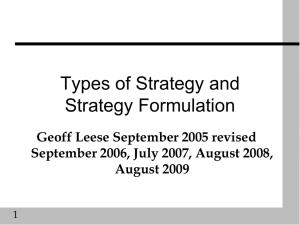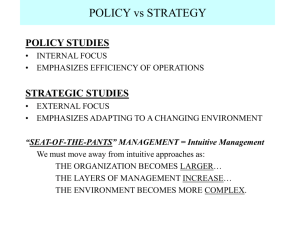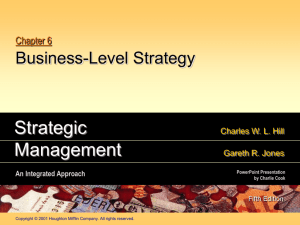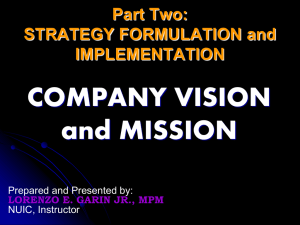Strategic Management 5e. (Hill & Jones)
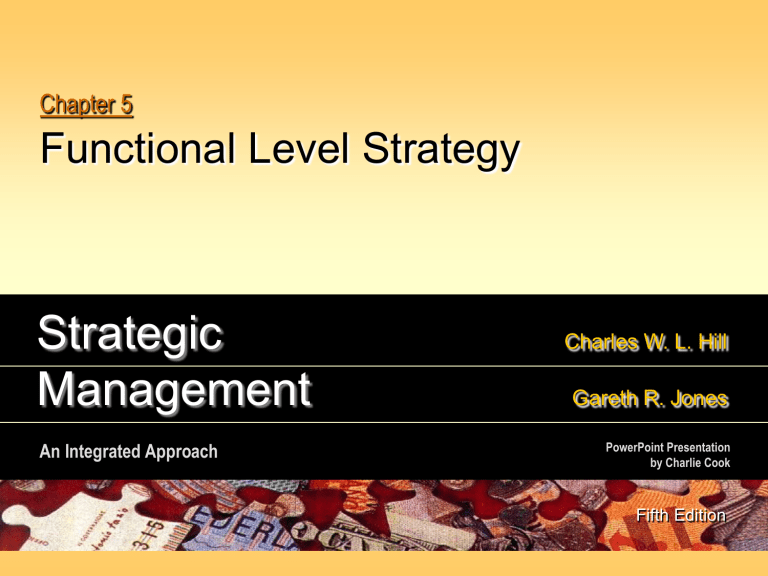
Chapter 5
Functional Level Strategy
Strategic
Management
An Integrated Approach
Charles W. L. Hill
Gareth R. Jones
PowerPoint Presentation by Charlie Cook
Fifth Edition
Production and Efficiency
Economies of scale
Lower unit costs due to large scale production volumes.
Learning effects
Cost reductions due to learning by doing.
The experience curve
Systematic unit-cost reductions that are the result of accumulated output.
4-2
FIGURE 5.1
Production and Efficiency:
Economies of Scale
A typical long-run unit-cost curve:
4-3
FIGURE 5.3
Production and Efficiency:
The Experience Curve
A typical experience curve:
4-4
FIGURE 5.2
Production and Efficiency:
Learning Effects
Economies of scale and learning effects:
4-5
Production and Efficiency: The Experience Curve
FIGURE 5.4
Unit production costs in an integrated steel mill and a minimill.
4-6
Production and Efficiency:
Manufacturing and Mass Customization
Flexible manufacturing technology (lean production)
Reduced setup times
Increased machine utilization
Improved quality control
Lower inventory levels
Mass customization
Low cost and product customization
Flexible machine cells
Increased variety of operations
4-7
Production and Efficiency: Flexible Manufacturing
FIGURE 5.5
The tradeoff between costs and product variety
4-8
Marketing and Efficiency
Marketing strategy:
Product design
Advertising
Promotion
Pricing
Distribution
4-9
FIGURE 5.6
The Relationship Between Average
Unit Costs and Customer
Defection Rates
4-10
FIGURE 5.7
The Relationship Between Customer
Loyalty and Profit per Customer
4-11
Materials Management, JIT, and Efficiency
Materials management
Getting materials into and through the production process and out through the distribution system to the end user.
Just-In-Time (JIT)
Reduce inventory holding costs by having materials arrive JIT to enter the production process.
JIT risk: There are no buffer stocks for nondelivery or unanticipated increases in demand.
4-12
R&D Strategy and Efficiency
Design easy-to-manufacture products
Reduce numbers of parts per unit.
Reduce assembly time.
Closely coordinate R&D and production activities.
Pioneer process innovations
Innovations create competitive advantage through gains in process efficiencies.
4-13
Achieving Superior Innovation
Causes of the high failure rate of innovation:
Uncertainty
Quantum innovation
Incremental innovation
Poor commercialization
Poor positioning strategy
Technological myopia
Slowness in marketing
4-14
Achieving Superior Customer
Responsiveness
Developing a customer focus:
Top leadership commitment to customers.
Employee attitudes toward customers.
Bringing customers into the company.
Satisfying customer needs:
Customization of the features of products and services to meet the unique need of groups and individual customers.
Reducing customer response times:
Marketing that communicates with production.
Flexible production and materials management.
Information systems that support the process.
4-15
Lec 4
Business-Level Strategy
Strategic
Management
An Integrated Approach
Charles W. L. Hill
Gareth R. Jones
PowerPoint Presentation by Charlie Cook
Fifth Edition
What Is Business-Level Strategy?
Business-level strategy
A plan of action to use the firm’s resources and distinctive competencies to gain competitive advantage.
Abell’s “Business Definition” process
Customer needs – product differentiation (what)
Customer groups – market segmentation (who)
Distinctive competencies – competitive actions (how)
4-17
Choosing a Generic Business-Level Strategy
Product/Market/Distinctive-Competency Choices and Generic Competitive Strategies
Product
Differentiation
Market
Segmentation
Distinctive
Competency
Cost Leadership Differentiation Focus
Low
(principally by price)
High
(principally by uniqueness)
Low to high
(price or uniqueness)
Low
(mass market)
Manufacturing and materials management
High
(many market segments)
Research and development, sales and marketing
Low
(one or a few segments)
Any kind of distinctive competency
TABLE 6.1
4-18
Types of Business-Level Strategies
FIGURE 6.1
4-19
Choosing a Business-Level Strategy
Cost-leadership strategy success is affected by:
Competitors producing at equal or lower costs.
The bargaining strength of suppliers.
Powerful buyers demanding lower prices.
Substitute products moving into the market.
New entrants overcoming entry barriers.
4-20
Choosing a Business-Level Strategy
Differentiation strategy success is achieved through:
An emphasis on product or service quality.
Innovation in providing new features for which customers will pay a premium price.
Responsiveness to customers after the sale.
Appealing to the psychological desires of customers.
4-21
Choosing a Business-Level Strategy
Differentiation strategy success is affected by:
Competitors imitating features and services.
Increases in supplier costs exceeding differentiator’s price premium.
Buyers becoming less brand loyal.
Substitute products adding similar features.
New entrants overcoming entry barriers related to differentiator’s competitive advantage.
4-22
Choosing a Business-Level Strategy
Focus strategy success is affected by:
Competitor entry into focuser’s market segment.
Suppliers capable of increasing costs affecting only the focuser.
Buyers defecting from market segment.
Substitute products attracting customers away from focuser’s segment.
New entrants overcoming entry barriers that are the source of the focuser’s competitive advantage.
4-23
Strategic Groups and Business-Level
Strategy
Implications for business-level strategy
Immediate competitors are companies pursuing same strategy within the same strategic group.
Different strategic groups can have a different standing with respect to the effects of the five competitive forces.
First mover advantage
Benefits are first choice of customers and suppliers, setting standards, building entry barriers.
4-24
Choosing an Investment Strategy at the Business Level
Investment strategy
The resources (human, functional, and financial) required to gain sustainable competitive advantage.
Competitive position
Market share is an indicator of competitive strength.
Distinctive competencies are competitive tools.
Life Cycle Effects
An industry’s life cycle stage affects its attractiveness to investment prospects.
4-25
Choosing an Investment Strategy at the
Business Level
Stage of the
Industry Life Cycle
Embryonic
Growth
Shakeout
Maturity
Decline
Strong Competitive
Position
Weak Competitive
Position
Share building Share building
Growth Market concentration
Share increasing Market concentration or harvest/liquidation
Hold-and-maintain or profit Harvest or liquidation/divestiture
Market concentration or harvest (asset reduction)
Turnaround, liquidation, or divestiture
TABLE 6.2
4-26

